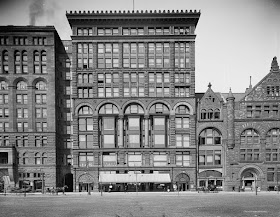Fine Arts Building, 410 S. Michigan Avenue
Home of the Cordon Club
Home of the Cordon Club
In the first
decades of the 20th century, the norm was for men and women to have
their own separate clubs. This did not
mean, however, that the clubs for the opposite sexes might not have similar
purposes. Such was the case with The
Cliff Dwellers and Cordon Clubs.
A well-known
fixture in Chicago for more than a century now is The Cliff Dwellers Club. Founded in 1907 as the Attic Club, and
renamed two years later, the goal of the club was to bring together men engaged
in and supportive of the fine arts. John
Glessner was a member, as were leading artists, authors, and architects
including Louis Sullivan. For decades
the Club occupied quarters on the top floor of Orchestra Hall (now Symphony
Center); since 1996 they have been perched atop the office building at the
southwest corner of Michigan Avenue and Adams Street.
Forgotten to
many is the fact that the women of Chicago had a similar club that occupied
nearby rooms in the Fine Arts Building at 410 S. Michigan Avenue. This week marks the 100th
anniversary of the opening reception of the Cordon Club, of which Frances Glessner was
a member.
Caroline
Kirkland, the long-time society columnist who wrote under the name “Madame X” for
the Chicago Tribune (she was a close
friend of Frances Glessner) provided a good overview of the opening of the club
in her article dated Sunday October 24, 1915.
“The much discussed Cordon, the feminine
counterpart of the Cliff Dwellers, is to have its opening reception next
Thursday afternoon in its highly artistic rooms on the seventh floor of the
Fine Arts building. It is an interesting
and promising undertaking, purporting to be a club for purely social purposes
and consisting largely of women with some profession or definite calling in
life.
Under this caption Mrs. Hobart
Chatfield-Taylor is entered on the lists as a bookbinder, Mrs. Tiffany Blake as
an expert landscape gardener, Mrs. Robert McGann as a painter, and Miss Helen
Birch as a musical composer.
The membership is limited to 400. It is full now, with a long waiting list of
candidates. It is about evenly divided
between women who “do something” and those who lead merely domestic and social
lives. Perhaps the professional women
predominate.
The club aims to provide a pleasant
gathering place for the members and their friends where they can meet and have
luncheon, dinner, or afternoon tea. The
rooms are decorated in the style of the Italian renaissance, modified by modern
ideas of comfort and convenience.
In choosing this period of art as the
background for the club’s social life, its president, Miss Clara E. Laughlin,
was governed by the thought that in the time of the Italian renaissance women
played a larger, more important part in Italian life than ever before – or ever
since, one might safely say. They exercised
a sway in politics and the world of learning which makes this period to the
student one of the most interesting in history.
So, as far as possible, the ideas that
governed the furnishing of interiors at that time are carried out in the rooms
of the Cordon. They have a fine copy of
a cinque cento fireplace; also an excellent production of a medieval Italian
doorway is one of the features of the main club room. High, somber wainscoting is the background,
and the general effect is rich and harmonious.
The name was chosen because the French
word “cordon” means many strands woven together.
Writers, musicians, artists, actresses,
business women, reformers, and women of wealth and leisure (if there is such a
thing as leisure) are on the club roster.
Besides those already mentioned other well known names are the Mesdames
Ogden Armour, Arthur Aldis, Chauncey Blair, Hobart Chatfield-Taylor, John
Carpenter, Jacob Baur, Benjamin Carpenter, Robert Peattie, Joseph T. Bowen,
Archibald Freer, John J. Glessner, John M. Clark, Kellogg Fairbank, Cyrus H.
McCormick, Horace Martin, William J. Calhoun, Potter Palmer, Fannie Bloomfield
Zeisler, Ella Flagg Young, and the Misses Grace and Edith Abbott, Edith Wyatt,
Louise Burnham, Jane Addams, Mary Bartelme, Anna Morgan, Harriet Monroe, Alice
French (Octave Thanet), Mary McDowell, Mabel Talliafero, and Frances
Starr. A shining galaxy!”
The club
maintained their quarters in the Fine Arts Building for decades. An article in the Chicago Tribune dated October 20, 1948 noted that the club rooms
had been recently redecorated:
“Coral predominates in the new color
scheme, and charcoal gray and mist green have been used for accent. Old furniture has been transformed with slip
covers, and several new pieces have been added, including mirrors, lamps, and
tables.”
The Cliff
Dwellers Club began admitting women many years ago, and in fact, the club has
had a woman president. So the idea of a
separate club just for women seems a bit foreign to many of us today. But in its day, the Cordon Club filled an
important niche in the social and artistic life of Chicago.
Note: The first president of the club, Miss Clara
E. Laughlin was a prominent writer, editor, and later a radio personality. Born in New York City in 1873 she lived most
of her life in Chicago, graduating from the Chicago High School in 1890. She wrote over three dozen books including
biographies of Sarah Bernhardt, Ferdinand Foch, and James Whitcomb Riley, as
well as her autobiography. In addition,
she wrote extensively for the Ladies Home
Journal. She died in 1941.


No comments:
Post a Comment